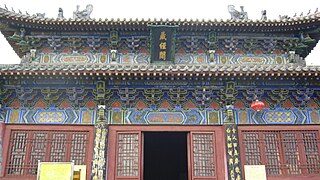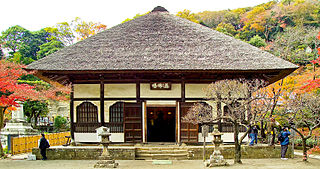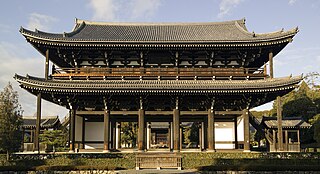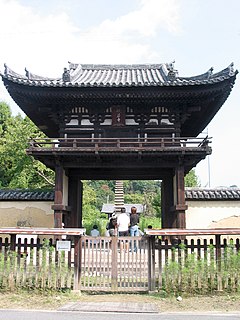 W
WJapanese Buddhist architecture is the architecture of Buddhist temples in Japan, consisting of locally developed variants of architectural styles born in China. After Buddhism arrived from the continent via Three Kingdoms of Korea in the 6th century, an effort was initially made to reproduce original buildings as faithfully as possible, but gradually local versions of continental styles were developed both to meet Japanese tastes and to solve problems posed by local weather, which is more rainy and humid than in China. The first Buddhist sects were Nara's six Nanto Rokushū , followed during the Heian period by Kyoto's Shingon and Tendai. Later, during the Kamakura period, in Kamakura were born the Jōdo and the native Japanese sect Nichiren-shū. At roughly the same time Zen Buddhism arrived from China, strongly influencing all other sects in many ways, including architecture. The social composition of Buddhism's followers also changed radically with time. In the beginning it was the elite's religion, but slowly it spread from the noble to warriors, merchants and finally to the population at large. On the technical side, new woodworking tools like the framed pit saw and the plane allowed new architectonic solutions.
 W
WThe Ōbaku school of Zen arrived in Japan in the middle of the seventeenth century, several centuries after the other Zen schools, and as a consequence its temples typically have a different architecture, based on Chinese Ming and Qing architectures.
 W
WBonshō , also known as tsurigane or ōgane are large bells found in Buddhist temples throughout Japan, used to summon the monks to prayer and to demarcate periods of time. Rather than containing a clapper, bonshō are struck from the outside, using either a handheld mallet or a beam suspended on ropes.
 W
WTokyō is a system of supporting blocks and brackets supporting the eaves of a Japanese building, usually part of a Buddhist temple or Shinto shrine. The use of tokyō is made necessary by the extent to which the eaves protrude, a functionally essential element of Japanese Buddhist architecture. The system has however always had also an important decorative function. The system is a more refined form of the Chinese Dougong that has evolved since its arrival into several original forms.
 W
WBuddhist Texts Library is a large building in Chinese Buddhist temples which is built specially for storing The Chinese Buddhist Canon (大藏經). It is encountered throughout East Asia, including in some Japanese Buddhist Kyōzōs (経蔵). The Chinese Buddhist Canon is the total body of Buddhist literature deemed canonical and was called "all the sutras" (一切經) in the ancient time. With four thousand kinds, it includes Āgama (經), Vinaya (律) and Abhidharma (論) texts. Āgama are theories made by Buddha for disciples to practice, Vinaya are the rules formulated by Buddha for believers and Abhidharma are the collection of theories explanations by Buddha's disciples.
 W
WDaibutsuyō is a Japanese religious architectural style which emerged in the late 12th or early 13th century. Together with Wayō and Zenshūyō, it is one of the three most significant styles developed by Japanese Buddhism on the basis of Chinese models.
 W
WDō . It is very often used in Japanese Buddhism as a suffix in the name of some of the many buildings that can be part of a Japanese temple compound. The prefix can be the name of a deity associated with it or express the building's function within the temple's compound.
 W
WThe Hall of Guru or Guru Hall, also known as the Founder's Hall, is the most important annex halls in Chinese Buddhist temples for enshrining masters of various Buddhism schools. It is encountered throughout East Asia, including in some Japanese Buddhist Kaisandos (開山堂). The Hall of Guru is generally situated to the west of the Mahavira Hall. Chan Buddhist temples usually have the Hall of Guru, which is followed by other schools' temples. Therefore three statues are always enshrined in the Guru Hall, namely the founder of the school, the senior monk who make significant contributions to the establishment of the school and the builder of the temple. Generally the Guru Hall in Chan Buddhism temples has Bodhidharma enshrined in the middle, the 6th Master Huineng's (638-713) statue on the left and Master Baizhang Huaihai's (720-814) statue on the right. Patriarch Bodhidharma and Damo for short, from south of ancient India, was the original ancestor of Chan Buddhism. The 6th Master Dajian Huineng was the actual founder of Chan Buddhism. After him, the Chan Buddhism in ancient China was almost changed and had far-reaching influence on Chinese traditional culture. Baizhang Huaihai was the third generation disciple of Huineng and his main achievements included: applying Chan Buddhism into practice, creating a set of regulations for Chan Buddhist temples and contributing to the steady development of Chan Buddhism.
 W
WKairō , bu (廡), sōrō or horō (歩廊) is the Japanese version of a cloister, a covered corridor originally built around the most sacred area of a Buddhist temple, a zone which contained the kondō and the tō. Nowadays it can be found also at Shinto shrines and at shinden-zukuri aristocratic residences.
 W
WKatōmado , also written as , is a style of pointed arch or bell-shaped window found in Japanese architecture. It first arrived in Japan from China together with Zen Buddhism, as an element of Zen style architecture, but from the end of the 16th century it started to be used in temples of other Buddhist sects, Shinto shrines, castles, and samurai residences as well. The window initially was not flared, but its design and shape changed over time: the two vertical frames were widened and curves were added at the bottom. The kanji characters used for its name have also changed through the centuries, from the original "fire window" to "flower head window".
 W
WKomainu (狛犬), often called lion-dogs in English, are statue pairs of lion-like creatures either guarding the entrance or the honden, or inner shrine of many Japanese Shinto shrines or kept inside the inner shrine itself, where they are not visible to the public. The first type, born during the Edo period, is called sandō komainu , the second and much older type jinnai komainu . They can sometimes be found also at Buddhist temples, nobility residences or even private homes.
 W
WKyōzō (経蔵) in Japanese Buddhist architecture is a repository for sūtras and chronicles of the temple history. It is also called kyōko (経庫), kyō-dō (経堂), or zōden (蔵殿). In ancient times the kyōzō was placed opposite the belfry on the east–west axis of the temple. The earliest extant kyōzō is at Hōryū-ji, and it is a two-storied structure. An example of one-storied kyōzō is at Tōshōdai-ji in Nara. A kyōzō's usual size is 3 x 3 ken.
 W
WMain hall is the building within a Japanese Buddhist temple compound (garan) which enshrines the main object of veneration. Because the various denominations deliberately use different terms, this single English term translates several Japanese words, among them butsuden, butsu-dō, kondō, konpon-chūdō, and hondō. Hondō is its exact Japanese equivalent, while the others are more specialized words used by particular sects or for edifices having a particular structure.
 W
WMon is a generic Japanese term for gate often used, either alone or as a suffix, in referring to the many gates used by Buddhist temples, Shinto shrines and traditional-style buildings and castles.
 W
WNijūmon is one of two types of two-story gate presently used in Japan, and can be found at most Japanese Buddhist temples. This gate is distinguishable from its relative by the roof above the first floor which skirts the entire upper story, absent in a rōmon. Accordingly, it has a series of brackets (tokyō) supporting the roof's eaves both at the first and at the second story. In a rōmon, the brackets support a balcony. The tokyō are usually three-stepped (mitesaki) with tail rafters at the third step. A nijūmon is normally covered by a hip-and-gable roof.
 W
WNiōmon is the Japanese name of a Buddhist temple gate guarded by two wooden warriors called Niō. The gate is called Heng Ha Er Jiang (哼哈二将) in China and Geumgangmun (금강문) in Korea. The two statues are inside the two posts of the gate itself, one at the left, one at the right. Structurally, it usually is either a rōmon or a nijūmon and can measure either 5x2 or 3x2 bays. It can sometimes have just one story, as in the case of Asakusa's Kaminarimon.
 W
WThe rōmon is one of two types of two-storied gate used in Japan. Even though it was originally developed by Buddhist architecture, it is now used at both Buddhist temples and Shinto shrines. Its otherwise normal upper story is inaccessible and therefore offers no usable space. It is in this respect similar to the tahōtō and the multi-storied pagoda, neither of which offers, in spite of appearances, usable space beyond the first story. In the past, the name also used to be sometimes applied to double-roof gates.
 W
WA sanmon , also called sangedatsumon , is the most important gate of a Japanese Zen Buddhist temple, and is part of the Zen shichidō garan, the group of buildings that forms the heart of a Zen Buddhist temple. It can be often found in temples of other denominations too. Most sanmon are 2- or 3-bay nijūmon, but the name by itself does not imply any specific architecture.
 W
WSetchūyō is an architectural style born in Japan during the Muromachi period from the fusion of elements from three different antecedent styles: wayō, daibutsuyō, and zenshūyō. It is exemplified by the main hall at Kakurin-ji. The combination of wayō and daibutsuyō in particular became so frequent that sometimes it is classed separately by scholars under the name Shin-wayō .
 W
WShichidō garan is a Japanese Buddhist term indicating the seven halls composing the ideal Buddhist temple compound. This compound word is composed by the word shichidō (七堂), literally meaning "seven halls", and garan (伽藍), meaning "temple". The term is often shortened to just garan. Which seven halls the term refers to varies, and it is also pointed out that 七堂 is possibly a misinterpretation of shitsudō (悉堂), meaning a complete temple. In practice, shichidō garan often simply means a large temple with many buildings. See below for more details about what are the possible seven buildings included.
 W
WThe shōrō, shurō or kanetsuki-dō is the bell tower of a Buddhist temple in Japan, housing the temple's bonshō (梵鐘). It can also be found at some Shinto shrines which used to function as temples, as for example Nikkō Tōshō-gū. Two main types exist, the older hakamagoshi (袴腰), which has walls, and the more recent fukihanachi (吹放ち) or fukinuki (吹貫・吹抜き), which does not.
 W
WSōmon is the gate at the entrance of a Buddhist temple in Japan. It often precedes the bigger and more important sanmon.
 W
WIn Japan, a tōrō is a traditional lantern made of stone, wood, or metal. Like many other elements of Japanese traditional architecture, it originated in China where they can still be found in Buddhist temples and Chinese gardens. They are not as common in Korea and Vietnam as they are in China or Japan. In Japan, tōrō were originally used only in Buddhist temples, where they lined and illuminated paths. Lit lanterns were then considered an offering to Buddha. Their use in Shinto shrines and also private homes started during the Heian period (794–1185).
 W
WWayō is a style developed in art and architecture in Japan during the Heian period, mainly by the esoteric sects Tendai and Shingon. Together with Zenshūyō and Daibutsuyō, it is one of the three most significant styles developed by Japanese Buddhism on the basis of Chinese models.
 W
WZenshūyō is a Japanese Buddhist architectural style derived from Chinese Song Dynasty architecture. Named after the Zen sect of Buddhism which brought it to Japan, it emerged in the late 12th or early 13th century. Together with Wayō and Daibutsuyō, it is one of the three most significant styles developed by Japanese Buddhism on the basis of Chinese models. Until World War II, this style was called karayō but, like the Daibutsuyō style, it was re-christened by Ōta Hirotarō, a 20th-century scholar. Its most typical features are a more or less linear layout of the garan, paneled doors hanging from hinges, intercolumnar tokyō, cusped windows, tail rafters, ornaments called kibana, and decorative pent roofs.